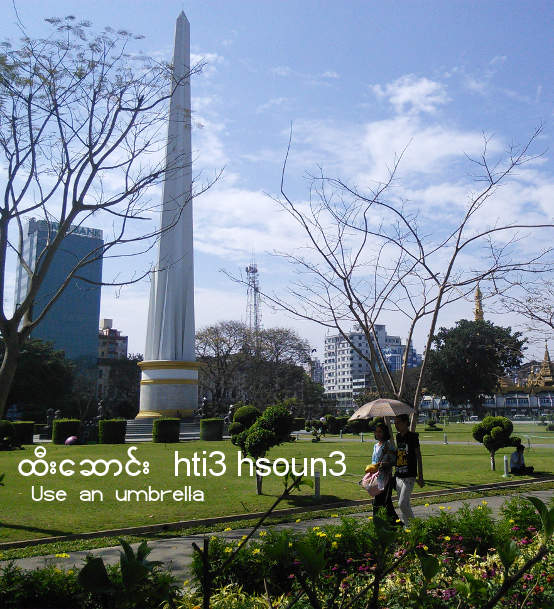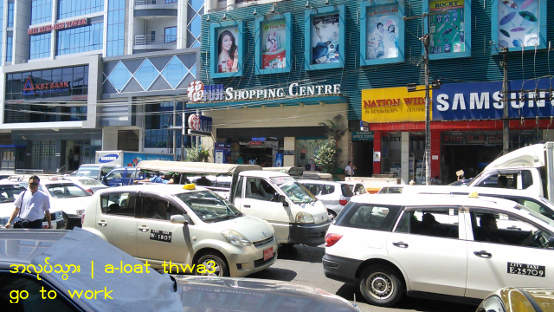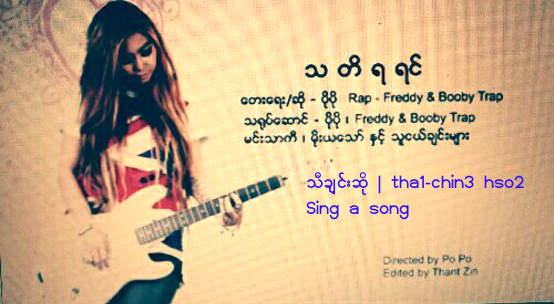Action Words — Burmese Verbs

So far we have been using some Burmese verbs ကြိယာ | kri1-ya2
![]() in the sentences. Here is a review (Sortable):
in the sentences. Here is a review (Sortable):
| AUDIO ↑↓ | BURMESE ↑↓ | ENGLISH ↑↓ |
|---|---|---|
| sa3 | စါး | eat |
| thwa3 | သွား | go |
| lo2 | လို | need |
| ga1-za3 | ကစား | play |
| na3 | နား | rest |
| loat | လုပ် | do something |
| pyay3 | ပြေး | run |
| cha1 | ချ | fight |
| la2 | လာ | come |
| ku2 | ကူ | help |
| kjite | ကြိုက် | like (something) |
| shi1 | ရှိ | have (something) |
| ya1 | ရ | be permitted; be available |
| sun3 | စမ်း | try out (something) |
| yone2 | ယုံ | believe; trust (someone) |
| leare2 | လည် | visit |
| yu2 | ယူ | take |
| yay3 | ရေး | write |
| thi1 | သိ | know (something) |
| khau2 | ခေါ် | call |
| yut | ရပ် | park the car; stop (e.g., at the security check point, officer says "yut!") |
| nay2 | နေ | stay |
| toe3 | တိုး | inch forward; push forward; move forward |
| hsoat | ဆုတ် | go backward; to retreat |
| kway1 | ကွေ့ | turn |
| ho3 | ဟိုး | stop (the vehicle) |
| tet | တက် | go up (the vehicle, stairs) |
| hsin3 | ဆင်း | go down; get down (e.g, from vehicle) |
| lite | လိုက် | come along |
| pay3 | ပေး | pay; give; hand over |
| leare3 | လဲ | exchange (money, merchandize, etc..) |
| kji1 | ကြည့် | watch |
| weare2 | ဝယ် | buy |
| ku3 | ကူး | cross the road. (Note: also to swim; to copy) |
| si3 | စီး | ride (car, bus, horse, bicycle, rickshaw, plane, train, boat, elevator, hot air balloon, etc..) |
In English, to watch is to look more attentively, not a casual glance by turning your head. You look, you see, and you watch if you like what you see. You see something only after you look — not you see first then look.
Myanmar language does not differentiate between "look" and "watch". ကြည့် | kji1 in Burmese means to watch as in တီဗွီကြည့် | TV kji1 — Watch TV as well as to take a look.
The negative imperative phrase will be မကြည့်နဲ့ | ma1-kji1 neare1 which means either "Don't Watch" or "Don't look".
မြင် | myin2, on the other hand, is perceiving or seeing something as you turn your head. So,
မြင်တိုင်းမကြည့်နဲ့ | myin2 dine3 ma1-kji1 neare1 means "Don't look (and pay attention) every time you see something."
Now, we will build up more vocabulary:
Category: Cleaning up
အဝတ် လျှော် | a-woot shau2 — wash clothes (clothes + wash)
ပန်းကန် ဆေး | ba1-gun2 hsay3 — wash dishes (plates + wash)
လက် ဆေး | let hsay3 — wash the hand (hand + wash)
ရေ ချိုး | yay2 cho3 — take a bath or shower (water + bathe)
ဖုန် သုတ် | pfone2 thoat — to dust (dust + wipe out)
အခန်း ရှင်း | a-khan3 shin3 — tidy up the room as in room service (room + tidy-up)
How to make requests in Burmese?
To say, "I want to ... " the general format is:
ချင်တယ် | xxxx chin2 deare2, where you substitute xxxx with the verb of your choice.
Examples:
အဝတ် လျှော် ချင်တယ် | a-woot shau2 chin2 deare2 — I want to wash clothes.
ရေ ချိုး ချင်တယ် | yay2 cho3 chin2 deare2 — I want to take shower.
လိုက် ချင်တယ် | lite chin2 deare2 — I want to come along.
To suggest something, add the particle "ba2" after the verb with the format:
xxxx ပါ | xxxx ba2
ပါ | ba2 softens the tone from ordering to suggesting. Note the difference:
တက် | tet — officer ordering the soldier to go up.
တက်ပါ | tet ba2 — Driver politely telling the passenger to go inside (up) the vehicle.
ပါဦး | ba2 ome3 — softens the tone even more.
စားပါဦး | sa3 ba2 ome3 "Won't you have (eat) some?
Please refer to Lesson 2 and 3 for basic sentence constructions. If you know the general pattern, you can just substitute the verbs in most cases.
Here are some more useful verbs and phrasal verbs:
Seeing a Doctor
ဆေး သောက် | hsay3 thout — take medication in liquid or tablet form (medicine + drink)
ဆေး ထိုး | hsay3 hto3 — inject with needle (medicine + punch or poke through)
ပြ | pya1 — to show
ဆရာဝန် ပြ | hsa1-ya2-woon2 pya1 — see a doctor. (doctor + show)
ဆရာဝန် ခေါ် | hsa1-ya2-woon2 khau2 — call a doctor. (doctor + call)
Communication
ဘာသာ ပြန် | ba2-dtha2 pyan2 — translate. (language or subject + translate)
ဖုန်း ခေါ် | pfone3 khau2 — make a phone call. (phone + call)
အီးမေးလ် ပို့ | e3-may3 po1 — send email. (email + send)
Emergency Situation
တက္ကစီ ခေါ် | tet-si2 khau2 — call taxi. (taxi + call)
သံရုံး သွား | thun2-yone3 thwa3 — go to the embassy. (embassy + go)
ရဲ တိုင် | yeare3 tine2 — make a police report. (police + report)
ဒေါ်လာ လဲ | dau2-la2 leare3 — exchange dollar into local currency.(dollar + exchange)
Waking Up in the morning
အိပ်ရာ ထ | ate-ya2 hta1 — wake up. (bed + stand)
အိမ်သာ ဝင် | ain2-dtha2 win2 — go to the bathroom. (toilet + enter)
မျက်နှာ သစ် | myet-hna2 thit — freshen up by washing the face. (face + new)
သွား တိုက် | thwa3 tite — brush teeth. (tooth + knock or rub)
မုတ်ဆိတ် ရိတ် | moat-hsate yate — shave. (beard + shave)
Preparing to go to work
မိတ်ကပ် လိမ်း | mate-kut lain3 — put on make-up and cosmetics. (cosmetic+ to rub)
သနပ်ခါး လိမ်း | tha1-nut-kha3 lain3 — put on burmese traditional cosmetic made from bark of a type of tree. Burmese women and children use this paste for protection from the sun.( a type of tree bark + to rub)
ခေါင်း ဖြီး | goun3 pfe3 — comb hair. (head + to comb)
အဝတ် လဲ | a-woot leare3 — change clothes. (clothes + change)
မနက်စါ စါး | ma1-net sa2 sa3 — have breakfast. (morning + portion + eat)
ဖိနပ် စီး | pfa1-nut si3 — put on footwear. (slippers, shoes + ride)
ထီး ဆောင်း | hti3 hsoun3 — use an umbrella. (umbrella + put up)
Morning Rush Hour

အလုပ် သွား | a-loat thwa3 — go to work. (work + go)
ကျောင်း သွား | kjoun3 thwa3 — go to school. (school + go)
အလုပ် ရှာ | a-loat sha2 — look for work. (work + search)
ဘတ်စကား စောင့် | but-sa1-ka3 soun1 — wait for the bus. (bus + wait)
ဘတ်စကား စီး | but-sa1-ka3 si3 — take a bus. (bus + ride)
ကား မောင်း | ka3 moun3 — drive a car. (car + drive)
On January 16, 2017 a new bus system (YBS) with new numbers were introduced in Yangon. See the routes with all the bus stops and detailed maps at http://ygnbusdirectory.com/.
At Work
အလုပ် တက် | a-loat tet — start work as in start of the shift. (work + go up)
အလုပ် လုပ် | a-loat loat — to work (work [noun] + to work [verb])
ဆွေးနွေး | hsway3-nway3 — discuss
တွက်ချက် | twet-chet — calculate; do the math.
ရေတွက် | yi2-twet — count
ပြင်ဆင် | pyin2-hsin2 — prepare
ကြော်ငြာ | kjau2-nya2 — advertise
စဉ်းစား | sin3-za3 — think
စေ့စပ် | say1-sut — negotiate
လူ ငှား | lu2-hnga3 — hire people. (people + rent/hire)
ငှားရမ်း | hnga3-yan3 — to rent
စစ်ဆေး | sit-hsay3 — inspect
ထိန်းသိမ်း | htain3-thain3 — maintain
ပြင် | pyin2 — repair
စမ်း | sun3 — to test
ဆင် (တပ်ဆင် သည်) | sin2 — assemble
ထုပ် (အထုပ် ထုပ်သည်) | htoat — pack
ရောင်းဝယ် | youn3 weare2 — buy & sell. (sell + buy)
ဆုံးဖြတ် | hsone3-pfyut — make decisions.
စီမံခန့်ခွဲ | si2-mun2 khan1-gweare3 — manage
အလုပ်ကြမ်း လုပ် | a-loat kjan3 loat — do a menial work. (job + rough + do)
စကား ပြော | za1-ga3 pyau3 — chit-chat (spoken language + speak)
အချိန် ဖြုန်း | a-chain2 pfyone3 — waste time. (time + waste)
Lunch Time
နေ့လယ်စာ စား | nay1-leare2 za2 sa3 — have lunch. (afternoon + portion + eat)
လက် ဆေး | let hsay3 — wash the hand. (hand + wash)
လက် သုတ် | let thoat — dry or clean the hand with napkin. (hand + wipe)
ပါးစပ် သုတ် | ba1-zut thoat — wipe the mouth clean with napkin. (mouth + wipe)
ရေ သောက် | yay2 thout — drink water. (water + drink)
အပေါ့ သွား | a-pau1 thwa3 — go to the restroom. (urine + go)
အနား ယူ | a-na3 yu2 — to rest. (a rest + take)
Back to Work
အလုပ် ပြန်လုပ် | a-loat pyan2 loat — resume work. (work [noun] + return + to work [verb])
လက်ဖက်ရည် သောက် | la1-pfet-yay2 thout — drink tea. (tea + drink)
နာရီ ကြည့် | na2-yi2 kji1 — look at the clock. (watch or clock + look or watch)
သွားဖို့ ပြင် | thwa3 bo1 pyin2 — prepare to go. (go + for + prepare
End of Shift
အလုပ် ဆင်း | a-loat hsin3 — to end work as in the end of shift and knock-off time (work [noun] + go down)
Oddly enough, it also refers to start work in the beginning of shift. For the later case, the reference point is probably going down the stairs of one's home.
ကျောင်း ဆင်း | kjoun3 hsin3 — finish class. (school + to go down); never use this for start of class.
အိမ် ပြန် | ain2 pyan2 — go back home. (house + to return, to repeat)
Back Home
တံခါး ဖွင့် | da1-ga3 pfwin1 — open the door. (door + open)
ဖိနပ် ချွတ် | pfa1-nut choot — remove footwear. (slippers, shoes + take-off) It is a Burmese custom to remove footwear at the door.
ထမင်း ချက် | hta1-min3 chet — cook rice. (rice + cook)
ဟင်း ချက် | hin3 chet — cook a dish which is eaten with rice. (dish + cook)
အင်္ကျီ ချွတ် | ain3-ji2 choot — take off the shirt. (shirt + take off)
ခေါင်း လျှော် | goun3 shau2 — shampoo hair. (head + wash)
ရေ ချိုး | yay2 cho3 — take a bath or shower. (water + bathe)
မီး ဖွင့် | mi3 pfwin1 — switch on the lights. (fire or light + open)
မီး ထွန်း | mi3 htoon3 — shine a flashlight or light up the lamp. (fire or light + light up)
ခြင်ဆေး ထွန်း | chin2 zay3 htoon3 — light up or to spray mosquito repellents. (mosquito + chemical compound + light up)
Dinner Time
ထမင်း စား | hta1-min3 sa3 — general term to have a meal. (rice + eat)
ဆု တောင်း | hsu1 toun3 — say Grace. [Christian rituals] (wish or trophy + ask for)
ညစာ စား | nya1 za2 sa3 — have dinner. (night + portion + eat)
စားပွဲ ရှင်း | za1-bweare3 shin3 — clean up the table. (table + tidy up)
ရေ ဖွင့် | yay2 pfwin1 — turn on the water, e.g., from the tap, faucet, pipe. (water + open)
ပန်းကန် ဆေး | ba1-gun2 hsay3 — wash dishes. (plates + wash)
ရေ ပိတ် | yay2 pate — turn off the water, e.g., from the tap, faucet (water + close)
Before going to bed
ရေဒီယို နားထောင် | ray2-de2-yo2 na3 htoun2 — listen to the radio. (radio + listen)
တီဗွီ ကြည့် | ti2-bwe2 kji1 — watch TV. (TV + to watch)
စာ ဖတ် | sa2 pfut — read a book; to study. (literature, letter, words + read)
ပန်ကာ ဖွင့် | pan2-ka2 pfwin1 — turn on the fan. (fan + open)
အဲကွန်း ဖွင့် | eare3-koon3 pfwin1 — turn on the air-conditioner. (air-cond. + open)
ဘုရား ရှိခိုး | pfa1-ya3 shit-kho3 — say prayers. [Buddhist rituals] (God or the Buddha or a symbol representing the Buddha + pay respect)
တီဗီ ပိတ် | ti2-bwe2 pate — switch off TV. (TV + close)
ခြင်ထောင် ချ | chin2-doun2 cha1 — set up a mosquito-net in the sleeping area. (mosquito net + pull down)
မီး ပိတ် | mi3 pate — switch off the light. (light or fire + close)
အိပ် | ate — sleep
Category: Basic Body Motions and 5 senses
ထိုင် | htine2 — sit
ထ | hta1 — stand up (maintain upright position)
လှဲ ( လဲလျောင်း ၊ လှဲလျောင်း ) | hleare3 — lie down
မ | ma1 — lift up
တွန်း | toon3 — push
ဆွဲ | hsweare3 — pull
ထမ်း | htan3 — carry on the shoulder
ကြား | kja3 — hear
မြင် | myin2 — see
ယူ | yu2 — take
ကိုင် | kine2 — hold with the hand
ကိုင်ထား | kine2 hta3 — keep holding on tight
လွှတ် လိုက် | hloot lite — release by ungrasping of the hand, by withdrawal of the foot, letting go mentally, or to physically release a captive.
ပြော | pyau3 — tell
ပြန် ပြော | pyan2 pyau3 — repeat what one said. (repeat + say)
အော် (အော်ဟစ်) | au2 — shout or scream
ပြန် လုပ် | pyan2 loat — repeat or do it one more time. (repeat + do)
Category: Office and Clerical
မိတ္တူ ကူး | mate-tu2 ku3 — make photocopies. (photocopy + copy)
ဓါတ်ပုံ ရိုက် | dut-pone2 yite — take photos. (photos + hit or strike)
ဖေါင် ဖြည့် | pfoun2 pfyay1 — fill up the form. (form + fill up)
လက်မှတ်ထိုး | let-hmut hto3 — sign one's name. (signature + punch)
ပိုက်ဆံ ပေး | pike-hsun2 pay3 — pay money. (money + pay)
လက်မှတ်ထိုး | let-hmut hto3 — formal word to sign one's name.
ငွေသွင်း | ngway2 thwin3 — make payment at the counter (money + deposit)
ချလန် ထုတ် | cha1-lun2 htoat — get the receipt (receipt + issue).
Category: Leisure
ရေ ကူး | yay2 ku3 — swim (water + swim)
လှေ လှော် | hlay2 hlau2 — row a boat. (boat + row)
ရွက်လှေ လှော် | ywet-hlay2 hlau2 — sail a boat. (sailing boat + sail)
တောင် တက် | toun2 tet — climb a mountain. (hill or mountain + go up)
လမ်းလျှောက် ထွက် | lun3-shout htwet — go out for a walk. (walk + come out)
စက်ဘီး စီး | set-bain3 si3 — ride a bicycle. (bicycle + ride)
ဈေး ဝယ် | zay3 weare2 — go shopping. (market + buy)
ဂေါက်သီး ရိုက် | gout-thi3 yite — play golf. (golf + hit or strike)
ဧည့်သည် ဖျော်ဖြေ | eare1-dtheare2 pfyau2-byay2 — entertain guests. (guest + entertain)
ခြင်းလုံး ခတ် | chin3-lone3 khut — play a non-competitive sport participated by a small group of people [usually 4 or 5] facing each other in a circular formation, where the objective of the game is to keep the ball made of cane in the air as long as possible by means of foot, shoulder, head, and parts of the body except the hand, and by passing around. (cane basket + ball + toss with foot)
အရက် သောက် | a-yet thout — drink alcohol (alcohol + drink)
သီချင်း ဆို | tha1-chin3 hso2 — sing a song (song + sing)

ရုပ်ရှင် ကြည့် | yoat-shin2 kji1 — watch movie (movie + to watch)
ဘုရားပွဲ သွား | pfa1-ya3 bweare3 thwa3 — go to night time festival at the pagoda compound where there are all-night shows as well as stalls selling food and variety of items in a Carnival style environment.(Pagoda + festival + go)
ဖဲ ရိုက် | pfeare3 yite — play cards (playing cards + hit or strike)
လောင်းကစား | loun3 ga1-za3 — gamble (gamble + play)
